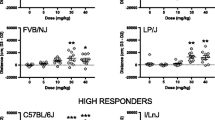Abstract
The purpose of the current study was to investigate genetic differences between two inbred strains of rats, Fisher-344 (F344/N) and Wistar Albino Glaxo (WAG/GSto), in a number of drug-naive and drug-related behaviors, including oral and intravenous morphine self-administration. F344/N and WAG/GSto rats differed in drug-naive behaviors such as nociception, rearing and sensitivity to lick suppression tests but did not differ in locomotor activity, ambulation or grooming behavior. F344/N rats were less sensitive to thermal stimuli as measured via tail-flick response, and more sensitive to the suppressive effects of intermittent shock in a lick suppression test. The F344/N rats demonstrated a significantly greater amount of rearing in open field tests but did not differ from WAG/GSto rats in locomotor activity, ambulation or grooming behavior. In addition to the behavioral results, naive F344/N and WAG/GSto rats were found to differ in μ and α2 receptor concentrations (F344/N>WAG/GSto) and in 5HT2 and D2 affinity constants (WAG/GSto>F344/N). These two inbred rat strains also differed in drug-related behaviors. F344/N rats showed significantly greater depression of locomotor activity at morphine 3 mg/kg than WAG/GSto rats. In addition, F344/N rats consumed significantly greater amounts of morphine in a two-bottle choice procedure and morphine maintained significantly greater amounts of behavior during intravenous self-administration sessions. Importantly, drug maintained behavior was significantly greater than with vehicle only in the F344/N rats during operant self-administration sessions.
Similar content being viewed by others
References
Belknap JK, Crabbe JC (1992) Chromosome mapping of gene loci affecting morphine and amphetamine responses in BXD recombinant inbred mice. In: Kalivas P, Samson H (eds) The neurobiology of alcohol and drug addiction. New York, pp 311–323
Belknap JK, O'Toole LA (1992) Studies of genetic differences in response to opioid drugs. In: Harris RA, Crabbe JC (eds) The genetic basis of alcohol and drug actions. Plenum, New York, pp 225–252
Cadoret RJ (1992) Genetic and environmental factors in initiation of drug use and the transition to abuse. In: Glantz MD, Pickens RW (eds) Vulnerability to drug abuse. American Psychological Association, Washington, DC, pp 99–113
Cadoret RJ, O'Gorman T, Troughton E, Heywood E (1986) An adoption study of genetic and environmental factors in drug abuse. Arch Gen Psychiatry 43:1131–1136
Cooper DO, Carlson KR, McKearney JW (1985) Comparison of regional CNS ligand binding in two inbred rat strains: effects of chronic morphine. Pharmacol Biochem Behav 23:349–354
Erdo F, Polgar K, Mate I, Szekely JI (1990) Modulation of dopamine-induced hypermotility following injection of various opioids into the nucleus accumbens. Acta Physiol Hung 76:219–227
George FR, Ritz MR, Elmer GI (1991) The role of genetics in drug dependence. In: Pratt J (ed) The biological basis of drug tolerance and dependence. Academic Press, New York, pp 265–290
Kuschinsky K, Hornykiewicz O (1972) Morphine catalepsy in the rat: relation to striatal dopamine metabolism. Eur J Pharmacol 19:119–122
Lowry OH, Rosebrough NJ, Farr AL, Randall RJ (1951) Protein measurement with Folin phenol reagent. J Biol Chem 139:265–275
Nichols JR, Hsiao S (1967) Addiction liability of albino rats: breeding for quantitative differences in morphine drinking. Science 157:561–563
O'Brien CP, Eherman RN, Ternes JW (1986) Classical conditioning in human opioid dependence. In: Goldberg SR, Stolerman IP (eds) Behavioral analysis of drug dependence. Academic Press, New York, pp 329–356
Oliverio A, Castellano C (1974) Genotype-dependent sensitivity and tolerance to morphine and heroin: dissociation between opiate-induced running and analgesia in the mouse. Psychopharmacologia 39:13–22
Piazza PV, Deminiere J-M, Le Moal M, Simon H (1989) Factors that predict individual vulnerability to amphetamine self-administration. Science 245:1511–1513
Pickens RW, Svikis DS, McGue M, Lykken DT, LLH, Clayton PJ (1991) Heterogeneity in the inheritance of alcoholism: a study of male and female twins. Arch Gen Psychiatry 48:19–28
Satinder KP (1977) Oral intake of morphine in selectively bred rats. Pharmacol Biochem Behav 7:43–49
Sudakov SK, Konstantinopolsky MA, Surkova LA, Tyurina IV, Borisova EV (1991) Evaluation of Wistar rats' individual sensitivity to the development of physical dependence on morphine. Drug Alcohol Depend 29:69–75
Suzuki T, Meisch RA, Goldberg SR, George FR (1992) Etonitazene delivered orally serves as a reinforcer for Lewis but not Fischer 344 rats. Pharmacol Biochem Behav 42:579–586
Uhl GR, Persico AM, Smith SS (1992) Current excitement with D2 dopamine receptor gene alleles in substance abuse. Arch Gen Psychiatry 49:157–160
Vogel JR, Beer B, Clody DE (1971) A simple and reliable conflict prodcedure for testing anti-anxiety agents. Psychopharmacology 21:1–7
Vonhof S, Siren A (1991) Reversal of mu-opioid-mediated respiratory depression by alpha 2 adrenoceptor antagonism. Life Sci 49:111–119
Author information
Authors and Affiliations
Rights and permissions
About this article
Cite this article
Sudakov, S.K., Goldberg, S.R., Borisova, E.V. et al. Differences in morphine reinforcement property in two inbred rat strains: associations with cortical receptors, behavioral activity, analgesia and the cataleptic effects of morphine. Psychopharmacology 112, 183–188 (1993). https://doi.org/10.1007/BF02244908
Revised:
Issue Date:
DOI: https://doi.org/10.1007/BF02244908




